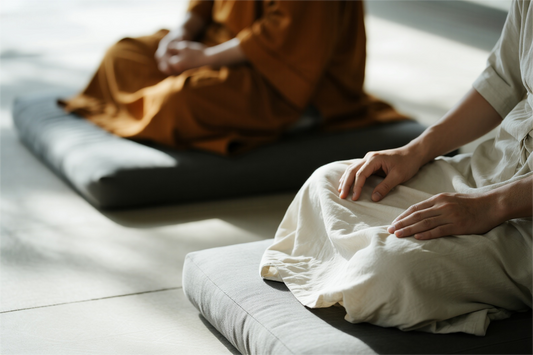
Introduction: Emptiness Brings Light
“When the room is empty, light enters. When movement ceases, auspiciousness arrives.”
— Zhuangzi
This poetic insight from Zhuangzi, one of Daoism’s greatest philosophers, captures the quiet heart of self-cultivation: clarity does not come from adding more, but from subtracting noise. In a world obsessed with speed, stimulation, and endless information, the ancient wisdom of stillness offers a rare, powerful alternative.
To cultivate the self through quietness is not to escape reality—but to see it clearly. In Chinese philosophy, this practice is known as “静以修身”—refining the self through inner stillness. It means developing awareness, balance, and virtue by turning inward, calming the heart, and watching the mind.
In modern life, this principle finds its reflection in the practices of mindfulness, meditation, and Zen-inspired presence. Especially in Southeast Asia, where Theravāda Buddhism and meditation culture are deeply rooted, stillness is not just a practice—it is a way of being.
I. What Does It Mean to Cultivate Stillness?
Stillness (jing) in classical Chinese thought does not mean absence or passivity. It means undisturbed awareness, a quiet mind that sees truthfully, acts deliberately, and resists the pull of chaos.
To cultivate stillness is to:
-
Observe thoughts without being swept away
-
Feel emotions without immediate reaction
-
Create space between stimulus and response
-
Allow insight to arise naturally, without force
It is a state of non-grasping clarity, a kind of inner spaciousness where wisdom can settle like dust in undisturbed air.
This stillness is not separate from life—it is how we meet life with depth.
II. The Noise of Modern Living
Today’s world is louder than ever—not just in sound, but in mental volume:
-
Notifications pull at attention every few minutes
-
Social comparison drains emotional energy
-
Constant multitasking fractures concentration
-
Endless consumption of content crowds the inner world
Even rest has become performative, optimized, and monetized. The result? Rising anxiety, emotional burnout, and spiritual fatigue.
Against this backdrop, stillness becomes a radical act of restoration. It reclaims the inner space we need to breathe, feel, and think clearly.

III. Meditation and Mindfulness: Ancient Wisdom in Modern Form
In recent years, mindfulness and meditation have gained global popularity. But their roots go deep into Buddhist, Daoist, and Confucian traditions—especially in Southeast Asia, where:
-
Thai forest monasteries preserve meditative silence
-
Burmese vipassanā centers emphasize awareness through breath and sensation
-
Vietnamese Zen teachers promote engaged mindfulness in daily life
These practices mirror jing yi xiu shen—stillness as moral and spiritual refinement.
Modern applications include:
-
Mindfulness-Based Stress Reduction (MBSR): using breath and body to calm the nervous system
-
Loving-Kindness Meditation: cultivating compassion toward self and others
-
Walking Meditation: synchronizing breath, step, and presence
-
Silent Retreats: unplugging from the external world to hear the internal one
In workplaces, schools, and homes, mindfulness is no longer fringe—it’s a science-backed, culture-crossing path to sanity.
IV. Quietness Is Not Emptiness—It’s Fullness Without Noise
Stillness is often misunderstood as dullness, but it is quite the opposite.
A still mind is:
-
Fully awake
-
Deeply engaged
-
Quietly resilient
Like water reflecting the moon, stillness reveals reality without distortion. In relationships, this means listening without preparing your reply. In work, it means focusing fully on one task instead of juggling five. In solitude, it means discovering peace in your own presence.
Stillness is not withdrawal—it’s precision. It gives you back control over your attention, your time, your soul.

V. The Sacred Power of Five Minutes a Day
You don’t need hours of meditation or a mountaintop temple to benefit from stillness. Just five minutes of intentional quiet each day can shift your emotional and energetic state.
Here’s a simple practice:
-
Sit upright, without strain. Let your hands rest gently.
-
Close your eyes, or lower your gaze.
-
Notice your breath—not changing it, just feeling it.
-
If thoughts arise, gently return to breath.
-
After 5 minutes, open your eyes slowly and smile.
With regular practice, this short pause becomes:
-
A reset button during stressful workdays
-
A source of calm in the middle of emotional storms
-
A daily ritual for reconnecting to yourself
Stillness doesn’t need to be mystical. It just needs to be consistent.
Conclusion: The Clear Mind Is a Deep Well
“When the room is empty, light enters.”
— Zhuangzi
Stillness is not the absence of life—it is the space in which life becomes visible. In the act of slowing down, we begin to see. In the silence, we begin to hear. And in the quiet mind, we rediscover our own presence.
In a noisy world, stillness is not a luxury. It is a form of survival—and eventually, a form of mastery.
To cultivate stillness is to cultivate the self.
To live in stillness is to act with wisdom.
To return to stillness each day—even for five minutes—is to return to the source of clarity, calm, and conscious living.




